Callum McLaughlin's Blog, page 11
January 31, 2021
January Wrap Up
For ease (mine and yours), I’ve decided to strip back my monthly wrap ups a bit. Rather than re-summarise my thoughts, I’ll simply share my rating with a link to my full review if you’d like more in-depth thoughts.
Though not strictly bookish, I’ll also share any embroidery projects I finished at the end of the post, since it’s taking up increasing amounts of my time, and some of you were very kind about the previous pieces I shared. (Thank you again for that; a love for embroidery was probably the only decent thing to come out of last year for me!)
But without further ado, let’s jump into it.
Books read: 8
Yearly total: 8
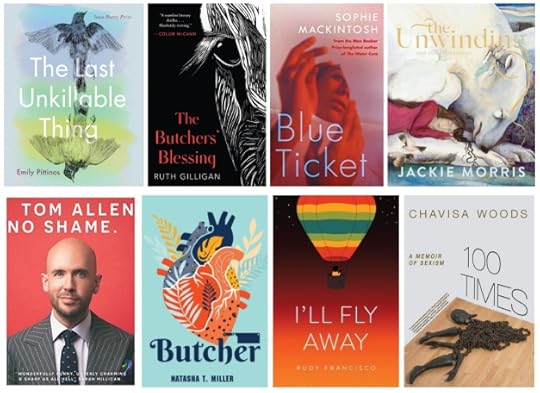



 | Review
| Review



 | Review
| Review




 | Review to come
| Review to come



 | Review
| Review


 | Review
| Review

 | Review
| Review



 | Review to come
| Review to come



 | Review
| Review
Favourite of the month: The Butcher’s Blessing
I enjoyed trying out a few different styles with my embroidery projects this month. The squirrel piece in particular is probably the most complex pattern I’ve taken on so far, and I’m really pleased with how it turned out!
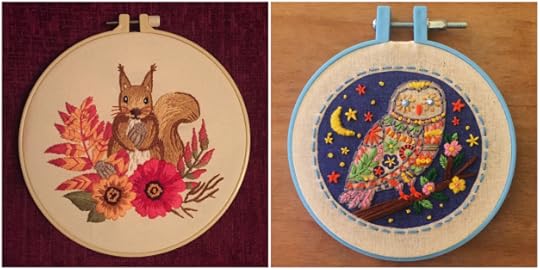

What was your favourite read in January?
January 30, 2021
Blue Ticket by Sophie Mackintosh | Book Review
Blue Ticket by Sophie Mackintosh
Published by Hamish Hamilton, 2020
Rating: 



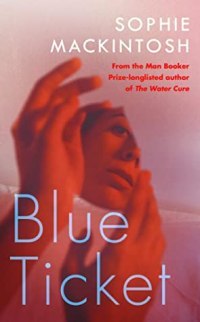 I’m not surprised to see that this attracted mixed reviews, my own opinion having changed multiple times throughout my time with it. Though not stated explicitly, it’s presumably set in a near-future Britain. On the day of their first period, all girls are allocated one of two tickets – white or blue – before being sent out into the world to fend for themselves. Having been monitored throughout their childhoods, the tickets dictate their fate: white ticket girls will marry and become mothers, while blue ticket girls are forbidden from conceiving. Calla, our narrator, was allocated a blue ticket, and though she doesn’t fully understand the strange, animal urges she feels, she longs to have a child of her own.
I’m not surprised to see that this attracted mixed reviews, my own opinion having changed multiple times throughout my time with it. Though not stated explicitly, it’s presumably set in a near-future Britain. On the day of their first period, all girls are allocated one of two tickets – white or blue – before being sent out into the world to fend for themselves. Having been monitored throughout their childhoods, the tickets dictate their fate: white ticket girls will marry and become mothers, while blue ticket girls are forbidden from conceiving. Calla, our narrator, was allocated a blue ticket, and though she doesn’t fully understand the strange, animal urges she feels, she longs to have a child of her own.
Despite how promising this setup sounds, the novel falls flat when taken as speculative dystopia. This is due to the undeniable contradictions and lapses in logic where the scant world-building is concerned. I’m fully on board with authors not spoon feeding everything to their readers, but the complete lack of context for the society we find here feels less like a writer leaving things open to interpretation, and more like her not having the answers herself.
Initially, I found this frustrating, but I was soon able to suspend my disbelief, swept up by the book’s many merits. When taking the setup less as genuine dystopian fiction and more as Mackintosh’s in to explore the policing of women’s bodies, freewill, motherhood, and desire, the novel becomes far more successful. I was pleased to see its social commentary become increasingly nuanced as the narrative progressed, assuaging several of my initial reservations. This includes exploration of the equally valid desire for women not to have children; the intersection of motherhood and queerness; the complexity of achieving true autonomy when parenthood is in many ways the ultimate sacrifice of independence; and the difficulty of forming a united front against patriarchal systems when they exist to turn women against each other.
It’s definitely more binary than it could have been in its look at gender as a whole, but Calla is a fascinating heroine; her story at once thrilling and full of psychological insight. Mackintosh’s prose is another highlight, beautiful despite the clinical air of numbness she establishes in Calla. She uses this skill to create a tone that is almost fable-esque, full of claustrophobic tension that swells towards inevitable tragedy.
I’m intrigued to see how my feelings about this one develop over time. Though it was undoubtedly flawed in its construction (particularly when viewed as a genre piece), it offered one of the most compelling reading experiences I’ve had for a while, cementing Mackintosh as one of my must-buy authors.
January 21, 2021
Rudy Francisco & Chavisa Woods | Mini Reviews
I’ll Fly Away by Rudy Francisco
Published by Button Poetry, 2021
Rating: 


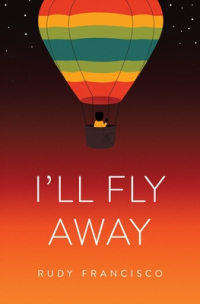 This collection is definitely at its strongest when Francisco tackles the topics of systemic racism and police brutality against Black people. In these pieces, there are some excellent, gut-punch lines that cut right to the quick.
This collection is definitely at its strongest when Francisco tackles the topics of systemic racism and police brutality against Black people. In these pieces, there are some excellent, gut-punch lines that cut right to the quick.
By contrast, the more insular, personal pieces are often hampered by overly-simplistic, clumsy imagery. It’s possible, however, that these lines would have more impact in a live setting, since I believe the poet comes from a performance background.
Frank, accessible, and contemporary in tone; I can certainly understand Francisco’s popularity.
Thank you to the publisher for a free advanced copy in exchange for an honest review.
100 Times by Chavisa Woods
Published by Seven Stories Press, 2019
Rating: 

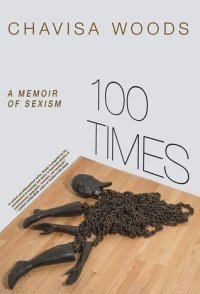 I feel very conflicted about this one, and am pained to not be writing a more positive review. It’s a case of a book that I hugely admire and recommend for its intention, but which I found frustrating in its execution.
I feel very conflicted about this one, and am pained to not be writing a more positive review. It’s a case of a book that I hugely admire and recommend for its intention, but which I found frustrating in its execution.
It chronicles, in a very matter-of-fact way, 100 examples of sexism that Woods has faced throughout her life, in an attempt to show just how pervasive it is within society. It’s exhausting and infuriating to bear witness to such a relentless string of harassment, abuse, assault, dismissal, intimidation, and condescension. I don’t underestimate for a moment how gratifying and powerful it will be for many women to see the reality of the injustice they face put to paper so clearly. Woods’ perspective as an openly queer woman, and her acknowledgment of the unique struggles faced by women of colour and transgender women, add some very welcome intersectionality.
On the other hand, the text is very repetitive. In terms of some of the anecdotes shared, this is deliberate; serving to show how monotonous and normalised misogyny has become. With regards to the simplistic prose, it’s a little harder to excuse, with the same phrasing used time and time again. This lack of light and shade, coupled with an almost regimented structure and tone, means some of its power is lost. There are also many examples in which Woods’ response to sexism is to immediately retaliate with physical violence: punching people, pushing them to the ground, spitting in their face, repeatedly striking them on the head, etc. I want to be clear that self-defence against threat or violence is a totally different matter, but generally speaking, I’m not a massive fan of combating problematic behaviour with further problematic behaviour. The ‘angry feminist’ trope is already used by those who seek to dismiss the validity of the movement; I couldn’t help but worry this book will fuel their misguided argument.
So, while I didn’t gel with the way she chose to deliver her message, the core point that Woods sets out to make is an important one, and I respect her frank refusal to accept inequality. There are definitely stylistic and personal preferences affecting my response, so I don’t doubt others will connect with it more than I did.
January 12, 2021
Natasha T. Miller & Tom Allen | Mini Reviews
Butcher by Natasha T. Miller
Published by Button Poetry, 2021
Rating: 



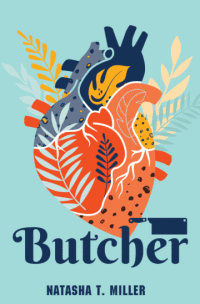 This collection of poems centres around Miller’s attempts to navigate grief after the loss of her brother, her mother’s alcoholism, and the everyday struggles she faces as a Black, queer woman in modern America.
This collection of poems centres around Miller’s attempts to navigate grief after the loss of her brother, her mother’s alcoholism, and the everyday struggles she faces as a Black, queer woman in modern America.
Miller’s experience as a performance poet and activist really shines through, even as her voice is condensed into text form. There’s a directness to her writing style that makes the pieces at once approachable and impactful. There’s no hiding behind complex rhythms or elaborate imagery here; the themes laid bare with gut-punch clarity. Given the scope of the topics at hand – racism, homophobia, love and loss – I’d argue they’re all the stronger for it.
The poems are divided into a few sections, named after different cuts taken from the body of a cow. Beyond the obvious raw, brutal connotations, this initially suggests the idea of breaking ourselves down into constituent parts; acting as metaphorical “butchers” so we can cut away the viscera and confront the very “meat” of our lives. The device/imagery isn’t used to any real effect, however, and ends up being somewhat superfluous. It’s the one area I felt would have benefitted from a little more depth of exploration.
Still, the immediacy and power of Miller’s words are sure to resonate widely, and I’m glad to have discovered her work.
Thank you to the publisher for a free advanced copy in exchange for an honest review.
No Shame by Tom Allen
Published by Hodder & Stoughton, 2020
Rating: 



 Tom’s wit, warmth, and honesty shine through in this charming yet poignant memoir. It centres around the idea of shame, with Tom sharing formative moments from throughout his life in which he was either cowed by the shame inflicted upon him by society, or when he actively defied it by embracing his own path.
Tom’s wit, warmth, and honesty shine through in this charming yet poignant memoir. It centres around the idea of shame, with Tom sharing formative moments from throughout his life in which he was either cowed by the shame inflicted upon him by society, or when he actively defied it by embracing his own path.
It’s a book about his journey to self-acceptance, particularly his long struggle to come out and feel comfortable in his own skin. Whilst nothing hugely revelatory, this means it does serve as a lovely “I see you” to anyone else who may be wrestling with internalised shame for simply wanting to be themselves.
There’s also a particularly nice focus on the importance of good teachers in providing safe spaces for children to explore their identities. (Big love to the drama teacher who encouraged Tom to see through his plan to perform a dramatic monologue in full drag at his school show; providing him with a dress and wig, and even helping him with his makeup.  Especially considering this was during the time of Section 28, meaning it could have cost her the job, it’s a lovely tribute to the key role of good allies in nurturing queer youth.)
Especially considering this was during the time of Section 28, meaning it could have cost her the job, it’s a lovely tribute to the key role of good allies in nurturing queer youth.)
January 4, 2021
Jackie Morris & Robert Macfarlane | Mini Reviews
The Lost Spells by Robert Macfarlane, illustrated by Jackie Morris
Published by Hamish Hamilton, 2020
Rating: 



 Following the huge success of their previous collaboration, The Lost Words, poet Robert Macfarlane and artist Jackie Morris have created another ode to the beauty of the natural world, and the importance of preserving the language we use to describe it.
Following the huge success of their previous collaboration, The Lost Words, poet Robert Macfarlane and artist Jackie Morris have created another ode to the beauty of the natural world, and the importance of preserving the language we use to describe it.
The text is always approachable, the playful imagery and lively rhythm making the poems ideal pieces to be read aloud. Take for example these excerpts from my favourite poem in the collection, Red Fox:
A bloom of rust
at your vision’s edge,
The shadow that slips
through a hole in the hedge,
My two green eyes
in your headlights’ rush,
A scatter of feathers,
the tip of a brush.
[…]
Shifter of shapes
and garbage-raider,
Bearer of fire
and space-invader,
Taker of risks
and riddle-maker,
Messenger, trickster,
curfew-breaker.
Morris’s accompanying artwork is gorgeous. It captures the very real majesty of each species covered while quietly hinting at something more magical, such is the atmosphere of reverence established within the book. I love the sentiment of the project as a whole, and would be more than happy to see the two continue working together.

The Unwinding by Jackie Morris
Published by Unbound, 2020
Rating: 




 If Morris’s collaborations with Macfarlane hint ever so subtly at something magical, here she leans fully into it. A series of vignettes crafted in text and watercolour, The Unwinding is best described less as a short story collection, and more as a series of dreams rendered on paper. You shouldn’t expect a rounded narrative arc or in-depth development, but you certainly can expect stunning artwork that evokes enchanting worlds, enigmatic characters, and an ethereal atmosphere. This elusive beauty is perfect for stimulating the imagination.
If Morris’s collaborations with Macfarlane hint ever so subtly at something magical, here she leans fully into it. A series of vignettes crafted in text and watercolour, The Unwinding is best described less as a short story collection, and more as a series of dreams rendered on paper. You shouldn’t expect a rounded narrative arc or in-depth development, but you certainly can expect stunning artwork that evokes enchanting worlds, enigmatic characters, and an ethereal atmosphere. This elusive beauty is perfect for stimulating the imagination.
The text we do get is simple yet charming; little pieces of flash fiction that read like a blend of prose poetry and magical realism. This tone is perfectly suited to the dreamlike quality of the visuals. The introduction itself explains that this text is merely intended as a jumping off point, however; one of many possible scenarios involving the vivid characters, settings, and lore hinted at in the artwork. Indeed, it is Morris’s hope that everyone will find their own meaning and interpret their own stories from the images, just as we would our dreams.
Each page is a treasure trove of sumptuous detail, cementing Morris as one of my favourite artists. I know I won’t be able to resist dipping in and out of this one regularly.

January 1, 2021
Reading Year in Review & 2021 Goals
In general, the less said about the horror show that was 2020, the better, right? Thankfully, there were some great books along the way to help keep me sane. So, as we head into the new year, let’s take stock of how I got on throughout the past 12 months and set some goals for 2021.
Firstly, a look at whether I achieved last year’s goals:
I wanted to read 100 books. Having read 121, this one gets a tick.
I wanted to read more poetry. I read 14 poetry books in 2020, up from just 4 in 2019, so that’s a big step in the right direction.
I wanted to do more buddy reads. I didn’t do many to be fair, so this is a fail. But with everyone (including myself) all over the place mentally and schedule-wise in 2020, I’m not going to beat myself up about it. And in fairness, my next goal kind of tied into this one…
I wanted to read the whole Women’s Prize for Fiction longlist. Though we read them in our own time, so they weren’t technically buddy reads, I did love the experience of reading and discussing the list with a bunch of my favourite bookish people again. I read and reviewed all 16 before the shortlist announcement, so this one gets a big tick.
I also wanted to keep reading translated lit. I definitely did this, both sporadically throughout the year and by committing fully to Women in Translation Month in August for the second year running.
In general, I certainly wouldn’t describe 2020 as one of my strongest reading years, but there were still lots of great books peppered throughout (the best of which I talked about here in my top reads of the year post). Across the 121 books I read, I gave an average rating of 3.5 stars, the same as in 2019. This seems pretty reflective of a somewhat middling reading year, but it definitely implies there were more good reads than bad ones!
As always, I never do or don’t read a book based on the author’s gender identity, but once the year reaches its end, I like to look back and see which voices I’m being drawn to. As expected, I’m definitely still reaching for female writers far more than I am male ones, and I’m more than okay with that. I’m also pleased to see my intake of non-binary voices increased slightly on the previous year (though it could certainly be higher, and recommendations would be very welcome!).
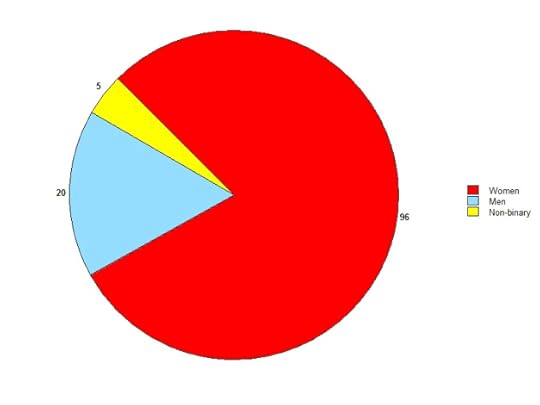
In terms of diversity of authorship within my reading, the ratio of white authors (78) to authors of colour (43) wasn’t too bad, but it could always be better. Publishing bias isn’t exactly a help on this front, but the closer I can get to a 50/50 split, the happier I’d be.
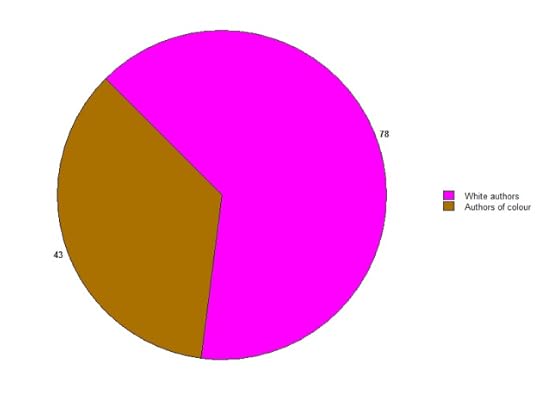
I then decided to break my reading down based on form. Amusingly, I read exactly the same number of both novels and nonfiction books in 2020 as I did in 2019. At the slight expense of short fiction and graphic novels/memoirs (both of which took a dip in numbers), I did manage to boost my poetry reading significantly, as previously mentioned, which I’m pleased about.
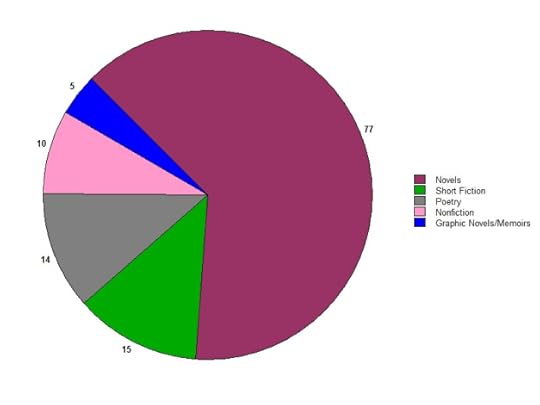
Given that one of my goals for the year was to keep reading translated literature, I wanted to see exactly what the numbers equated to. Though books written in English certainly make up the bulk of my reading, I was reasonably happy with the balance. Ideally, I’d love for translated works to make up at least a quarter of my reading, which seems attainable based on these stats.
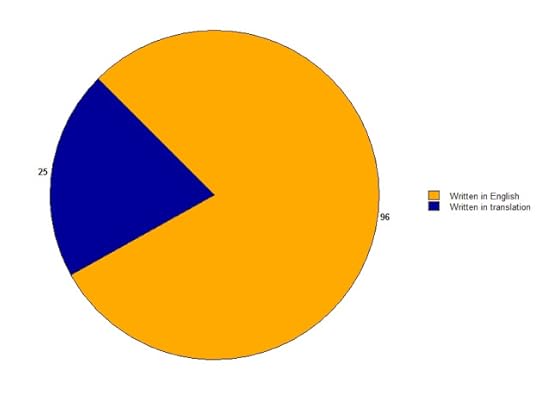
As for 2021, in light of how up in the air everything still feels, I’m keeping my goals very simple:
Read 100 books. I like that this is a round number, and that it feels achievable whilst still making a sizable dent in my ever-growing TBR.
Read more plays. I don’t reach for plays that often, but I’ve had several end up on my reads of the year lists before. I’m also really missing the experience of live theatre, so reading play scripts may help to ease that particular ache.
Finish Carrie Fisher’s backlist. This is very specific, I grant you. I love Fisher’s writing, both fiction and nonfiction. I’ve read 5 out of her 7 published works so far, and I’ve been putting off the last 2 because the thought of not having more of her books to look forward to makes me sad. But equally, as a big fan, I want to be able to say I’ve completed her works.
Pace myself. My reading definitely slowed down throughout the last couple of months in 2020. As a committed reader, this stressed me out at first, but I think we’ve all learned to try and be a little kinder to ourselves recently. I tell everyone else it’s absolutely fine to take breaks from reading when you feel burnt out or in a slump, so I want to take my own advice if/when it happens to me again. It’s also true that a lot of the time I would normally have spent reading in those latter months was spent indulging my newfound love of embroidery, so it’s not like I wasn’t doing something enjoyable and relaxing with my time anyway!
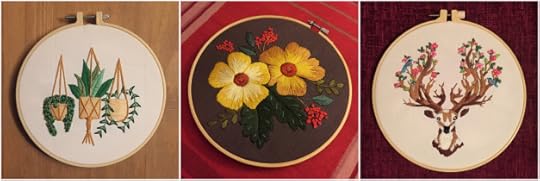
The pieces I embroidered in November

A couple of festive pieces I embroidered in December
I’ll end this post as I always end my reading year in review; by bringing together every book I read throughout the past 12 months. If any covers or titles catch your eye, feel free to ask about them and we can chat. In the meantime, happy reading, and all the best for 2021! Things can only get better, right?
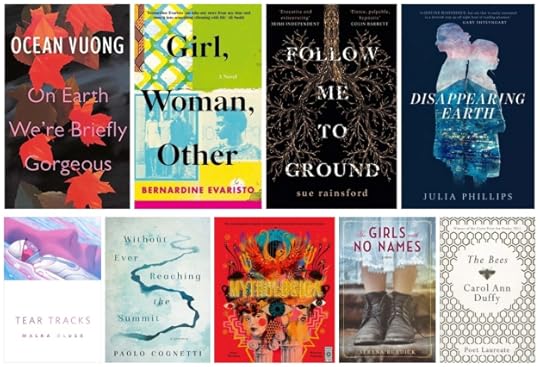
The books I read in January
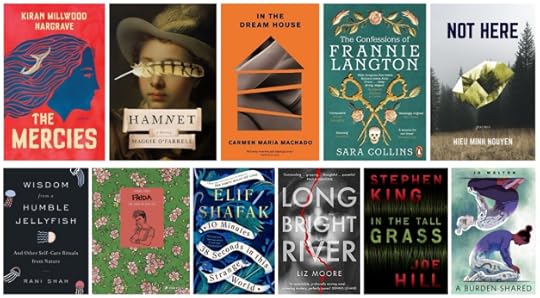
The books I read in February
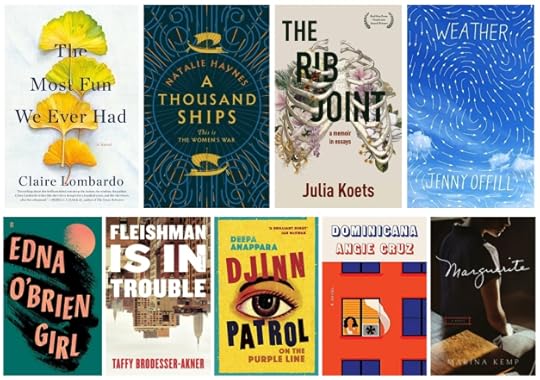
The books I read in March
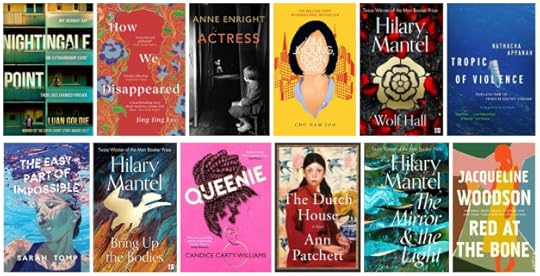
The books I read in April

The books I read in May
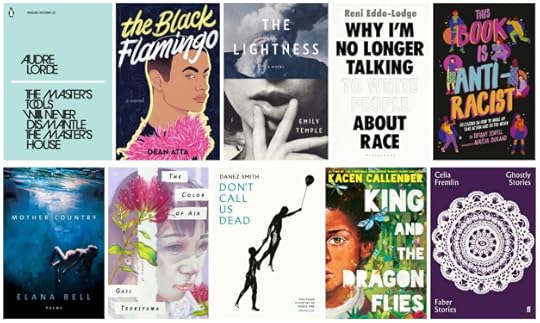
The books I read in June
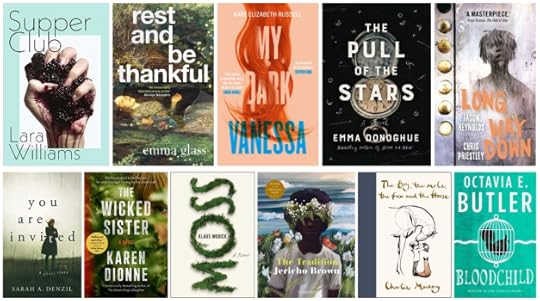
The books I read in July
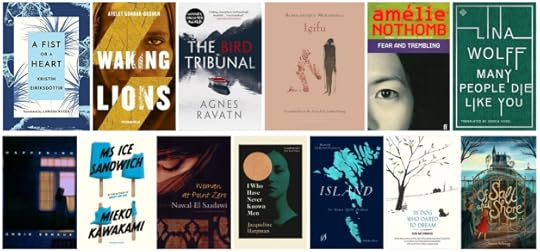
The books I read in August

The books I read in September
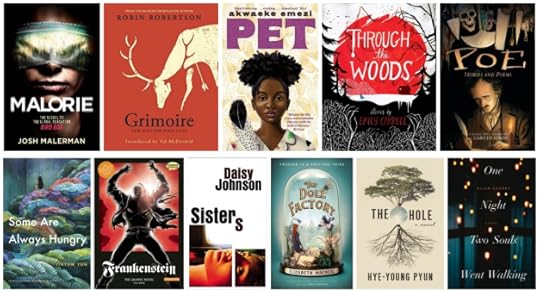
The books I read in October
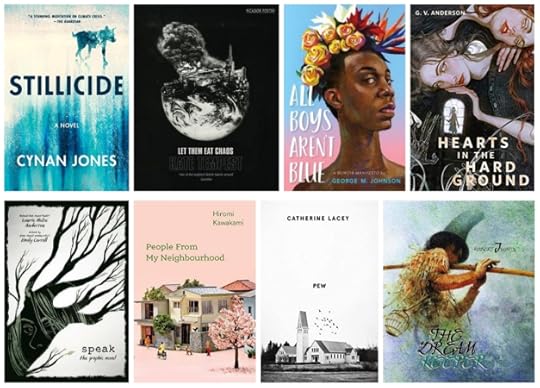
The books I read in November
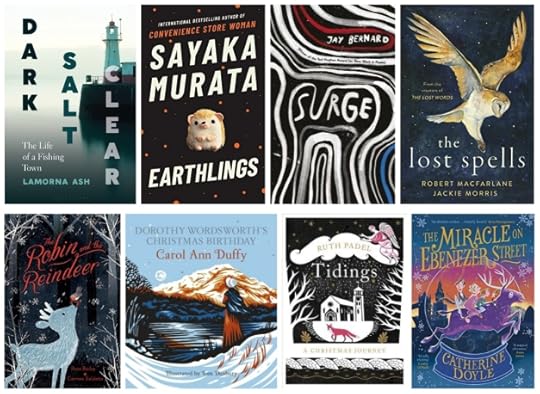
The books I read in December
December 31, 2020
December Wrap Up

The books I read in December
Before thoughts turn fully to the year ahead, there’s just time for one last wrap up. I read 8 books throughout December, bringing my final total for the year up to 121. Here are some brief thoughts on each of them, with links to my full reviews if you’d like to know more.
Dark, Salt, Clear by Lamorna Ash
[ 


 ] Full review to come for BookBrowse
] Full review to come for BookBrowse
Surge by Jay Bernard
[ 


 ] By looking at the similarities in the handling of both the New Cross Massacre and the Grenfell Tower disaster, this harrowing collection of poems exposes the persistence of systemic racism, economic inequality, and bias within the UK’s police and media. Though a couple of more personal pieces felt somewhat out of place, Bernard’s style is approachable yet compelling.
] By looking at the similarities in the handling of both the New Cross Massacre and the Grenfell Tower disaster, this harrowing collection of poems exposes the persistence of systemic racism, economic inequality, and bias within the UK’s police and media. Though a couple of more personal pieces felt somewhat out of place, Bernard’s style is approachable yet compelling.
Earthlings by Sakaya Murata, translated from the Japanese by Ginny Tapley Takemori
[ 


 ] This discomfiting novel is concerned with those who fail to adhere to society’s norms, and the notion of storytelling as a means of self-protection. Though I found the climax’s descent into madness too extreme and abrupt to be believable, the book as a whole is gripping and provocative.
] This discomfiting novel is concerned with those who fail to adhere to society’s norms, and the notion of storytelling as a means of self-protection. Though I found the climax’s descent into madness too extreme and abrupt to be believable, the book as a whole is gripping and provocative.
The Robin and the Reindeer by Rosa Bailey & Carmen Saldana
[ 


 ] A beautifully illustrated and hugely charming children’s story about bravery and trust, this offers ideal cosy escapism on a cold winter’s day for readers young and old alike.
] A beautifully illustrated and hugely charming children’s story about bravery and trust, this offers ideal cosy escapism on a cold winter’s day for readers young and old alike.
Tidings by Ruth Padel
[ 

 ] This extended poem told from multiple perspectives contrasts the joy of a young girl’s Christmas with the pathos of a homeless man’s. It’s messages about remembering the true meaning of Christmas, and hope born of kindness and connection, are admirable if heavy-handed.
] This extended poem told from multiple perspectives contrasts the joy of a young girl’s Christmas with the pathos of a homeless man’s. It’s messages about remembering the true meaning of Christmas, and hope born of kindness and connection, are admirable if heavy-handed.
The Miracle on Ebenezer Street by Catherine Doyle
[ 


 ] A radical, modern reimagining of Dickens’ A Christmas Carol, this middle grade novel about confronting grief embraces both the magic and the sadness often inherent to Christmas. It’s bittersweet yet fun and ultimately hopeful.
] A radical, modern reimagining of Dickens’ A Christmas Carol, this middle grade novel about confronting grief embraces both the magic and the sadness often inherent to Christmas. It’s bittersweet yet fun and ultimately hopeful.
Dorothy Wordsworth’s Christmas Birthday by Carol Ann Duffy
[ 


 ] A simple, cosy poem that captures the beauty of domesticity and time spent with loved ones at Christmastime. The vivid imagery is complimented perfectly by Tom Duxbury’s gorgeous illustrations.
] A simple, cosy poem that captures the beauty of domesticity and time spent with loved ones at Christmastime. The vivid imagery is complimented perfectly by Tom Duxbury’s gorgeous illustrations.
The Lost Spells by Robert Macfarlane, illustrated by Jackie Morris
[ 


 ] Another lovely collaboration that brings together the lively poems of Macfarlane and the stunning artwork of Morris. It’s a heartfelt, lyrical celebration of the natural world and the language we use to describe it.
] Another lovely collaboration that brings together the lively poems of Macfarlane and the stunning artwork of Morris. It’s a heartfelt, lyrical celebration of the natural world and the language we use to describe it.
There we have it! My favourite read of the month was Earthlings. What was yours?
Connect: Twitter | Goodreads | Ko-fi
December 29, 2020
Top Reads of 2020
It’s fair to say 2020 was… not a great year all round. However, as I write this, I’ve managed to read 120 books throughout all the madness (I may just about squeeze one or two more in before the year ends). As ever, I’m excited to count down my 10 favourites here. Aside from quickly listing a few honourable mentions – Don’t Call Us Dead by Danez Smith, The Master’s Tools Will Never Dismantle the Master’s House by Audre Lorde, and Let Them Eat Chaos by Kae Tempest – let’s just jump right into it, shall we?
Follow Me to Ground by Sue Rainsford
 This was a bit of a sleeper hit in that it didn’t immediately stand out as a contender for this list when I read it, but it has stayed with me strongly ever since. We follow a not-quite-human father and daughter who use their strong ties to the earth to cure sickness and injury among their neighbours. Though things remain a little more elusive than I would have liked, the striking imagery, visceral prose, and otherworldly atmosphere kept me hooked. A startlingly singular read, it manages to balance several fascinating themes, including the language used to describe women’s bodies, the vilification of feminine power, the magic of the natural world, the cost of intimacy, and the folly of sacrificing our own desires in an attempt to please or change others.
This was a bit of a sleeper hit in that it didn’t immediately stand out as a contender for this list when I read it, but it has stayed with me strongly ever since. We follow a not-quite-human father and daughter who use their strong ties to the earth to cure sickness and injury among their neighbours. Though things remain a little more elusive than I would have liked, the striking imagery, visceral prose, and otherworldly atmosphere kept me hooked. A startlingly singular read, it manages to balance several fascinating themes, including the language used to describe women’s bodies, the vilification of feminine power, the magic of the natural world, the cost of intimacy, and the folly of sacrificing our own desires in an attempt to please or change others.
The Confessions of Frannie Langton by Sara Collins
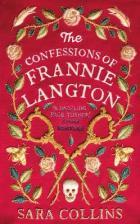 This richly evocative historical fiction novel follows a black woman facing the death penalty for the supposed killing of her white master and mistress. Serving as her testimony, the book takes us all the way from her birth on a plantation in Jamaica to her incarceration in London, as she attempts to make sense of the life she has lived and prove her innocence.
This richly evocative historical fiction novel follows a black woman facing the death penalty for the supposed killing of her white master and mistress. Serving as her testimony, the book takes us all the way from her birth on a plantation in Jamaica to her incarceration in London, as she attempts to make sense of the life she has lived and prove her innocence.
Frannie is a phenomenally well-drawn character. Complex, intelligent, passionate, and unfalteringly human; it’s her flaws that make her so easy to root for. Collins’ visceral and immersive prose is equally fantastic, as she navigates the nuanced themes of culpability, gender, sexuality, and autonomy.
Leave the World Behind by Rumaan Alam
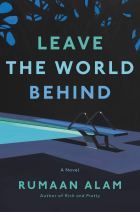 This is proving the be a real marmite book, but fortunately for me, I’m one of the ones who loved it. A masterclass in delayed tension, it follows two families who must seek to overcome their differences and survive what may be the end of days. Though I can understand and appreciate the thematic implications behind both creative choices, the dense prose and ambiguous ending will definitely alienate some. Meticulously paced and punctuated by striking imagery throughout, however, Alam creates a singular atmosphere that is as discomfiting as the plot itself. Tense and anxiety-inducing, even the quietest moments simmer with an undercurrent of threat; the book asking critical questions about trust, race, family, and control.
This is proving the be a real marmite book, but fortunately for me, I’m one of the ones who loved it. A masterclass in delayed tension, it follows two families who must seek to overcome their differences and survive what may be the end of days. Though I can understand and appreciate the thematic implications behind both creative choices, the dense prose and ambiguous ending will definitely alienate some. Meticulously paced and punctuated by striking imagery throughout, however, Alam creates a singular atmosphere that is as discomfiting as the plot itself. Tense and anxiety-inducing, even the quietest moments simmer with an undercurrent of threat; the book asking critical questions about trust, race, family, and control.
Loyalties by Delphine de Vigan, tr. from the French by George Miller
 Told from four perspectives that weave together towards an inevitably tragic conclusion, this is primarily a look at the concept of loyalty in its various forms, and the moral dilemma of breaching someone’s trust when it may be the best thing for them.
Told from four perspectives that weave together towards an inevitably tragic conclusion, this is primarily a look at the concept of loyalty in its various forms, and the moral dilemma of breaching someone’s trust when it may be the best thing for them.
With each of the protagonists attempting to keep a secret on behalf of someone else, a sense of tension and claustrophobia builds throughout, as does some very clever commentary on sexism, abuse, and agency. The unassuming skill of its construction somehow heightens the book’s emotional impact, making this a real hidden gem I’d love to see more people pick up.
Grimoire by Robin Robertson
 I picked up this collection of narrative poems on a whim and I’m so glad I did! From stories of ghosts, witches and doppelgängers, to tales of selkies and changelings, the poems draw on Scotland’s rich tradition of mythology and storytelling to explore themes of heartache, revenge, and transformation, often focussing on those who are vilified by society for their differences. I love Robertson’s use of language. It’s lyrical yet always so readable, with hauntingly macabre imagery that is perfectly suited to the dark nature of the subject matter. Simple yet haunting illustrations – provided by Robertson’s brother, Tim – are peppered throughout as well. Compared in the blurb to cave paintings, these striking images do indeed possess an eerie timelessness that enhances the impact of the book as a whole.
I picked up this collection of narrative poems on a whim and I’m so glad I did! From stories of ghosts, witches and doppelgängers, to tales of selkies and changelings, the poems draw on Scotland’s rich tradition of mythology and storytelling to explore themes of heartache, revenge, and transformation, often focussing on those who are vilified by society for their differences. I love Robertson’s use of language. It’s lyrical yet always so readable, with hauntingly macabre imagery that is perfectly suited to the dark nature of the subject matter. Simple yet haunting illustrations – provided by Robertson’s brother, Tim – are peppered throughout as well. Compared in the blurb to cave paintings, these striking images do indeed possess an eerie timelessness that enhances the impact of the book as a whole.
The Pull of the Stars by Emma Donoghue
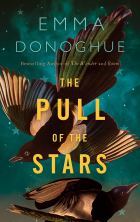 Set during the final months of WWI, just as the so-called Spanish Flu was hitting its peak, The Pull of the Stars chronicles three harrowing days on a makeshift maternity ward in Dublin. Donoghue succeeds in capturing the abject horror of a city blighted by the cumulative effects of war and disease. Though she never shies away from detailing the utter devastation racking people’s bodies, there’s a tenderness that grounds the narrative and stops it from tipping into gratuitous suffering. Thematic parallels with current events are impossible to ignore, and though it will resonate more strongly for some as a result, the book is good enough to stand on its own regardless. The narrative is gripping, and the characters endearing, but with an overall tone that is fiercely feminine, the book serves as a love letter to all the women who sacrifice themselves mind, body and soul in the name of caring for others.
Set during the final months of WWI, just as the so-called Spanish Flu was hitting its peak, The Pull of the Stars chronicles three harrowing days on a makeshift maternity ward in Dublin. Donoghue succeeds in capturing the abject horror of a city blighted by the cumulative effects of war and disease. Though she never shies away from detailing the utter devastation racking people’s bodies, there’s a tenderness that grounds the narrative and stops it from tipping into gratuitous suffering. Thematic parallels with current events are impossible to ignore, and though it will resonate more strongly for some as a result, the book is good enough to stand on its own regardless. The narrative is gripping, and the characters endearing, but with an overall tone that is fiercely feminine, the book serves as a love letter to all the women who sacrifice themselves mind, body and soul in the name of caring for others.
Rest and Be Thankful by Emma Glass
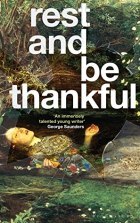 For its relatively short length, this packs a hefty punch. We follow Laura, a paediatric nurse, as the physical and emotional demands of her job become increasingly all consuming. With exhaustion taking hold and her relationship falling apart, strange nightmares begin to bleed into her days. There’s such a gentleness to much of the book, but it is this distinctly quiet grace that lends several moments their devastating power.
For its relatively short length, this packs a hefty punch. We follow Laura, a paediatric nurse, as the physical and emotional demands of her job become increasingly all consuming. With exhaustion taking hold and her relationship falling apart, strange nightmares begin to bleed into her days. There’s such a gentleness to much of the book, but it is this distinctly quiet grace that lends several moments their devastating power.
Glass employs a lot of exaggerated metaphors, but there are beautiful passages that read like prose poetry. In this context, the almost cloying text mirrors the heavy atmosphere and the increasingly hypnotic, otherworldly tone of the narrative, with brilliantly employed flirtations with the supernatural used to explore the notions of unaddressed trauma, and deteriorating mental health as a result of a distinct lack of support for medical staff – a very real problem that hits home harder than ever following widespread devastation on hospital wards in 2020.
Tender is the Flesh by Augustina Bazterrica, tr. from the Spanish by Sarah Moses
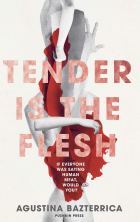 In this horrifying gem from Argentina, a virus has made all animal meat toxic to humans. In a frighteningly short span of time, the consumption of human flesh has been legalised, with breeding centres now commonplace, the ownership of “domestic” humans not unusual, and the public largely desensitized to everything that’s going on. The world-building and pacing throughout this speculative, all-too-plausible dystopian are handled brilliantly. There’s no clumsy exposition, and every detail we learn about the degradation of society is more disturbing than the last. It’s a book about what it means to be human, and what it means to have loved and lost. It’s also a book about power, complicity, family, and mankind’s unwavering instinct to both survive and dominate.
In this horrifying gem from Argentina, a virus has made all animal meat toxic to humans. In a frighteningly short span of time, the consumption of human flesh has been legalised, with breeding centres now commonplace, the ownership of “domestic” humans not unusual, and the public largely desensitized to everything that’s going on. The world-building and pacing throughout this speculative, all-too-plausible dystopian are handled brilliantly. There’s no clumsy exposition, and every detail we learn about the degradation of society is more disturbing than the last. It’s a book about what it means to be human, and what it means to have loved and lost. It’s also a book about power, complicity, family, and mankind’s unwavering instinct to both survive and dominate.
I found it (deliberately) repellent and utterly compelling in equal measure. Bazterrica repeatedly forces us to ask why we value some lives above others, but for all its boldness, there’s also a lot of nuance, with commentary on the likes of genetic modification, hunting for sport, human trafficking, class disparity, and the power of language, all woven in seamlessly.
The Doll Factory by Elizabeth Macneal
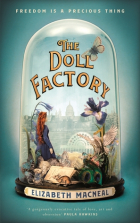 Set in 1850s London, this wonderfully evocative debut looks at art, autonomy, love, and obsession. We follow Iris, a young woman who agrees to model for an up-and-coming artist on the condition that he tutor her in painting. But Iris has an admirer; a mysterious, sinister figure who is watching from the shadows. Macneal’s writing is lush and intoxicating; the sights, scents and sounds of Victorian London practically leaping from the page. Equally, Iris is an excellent heroine: talented, ambitious, headstrong, and determined to succeed in a man’s world. Indeed, the book has great things to say about the limitations placed on women at the time.
Set in 1850s London, this wonderfully evocative debut looks at art, autonomy, love, and obsession. We follow Iris, a young woman who agrees to model for an up-and-coming artist on the condition that he tutor her in painting. But Iris has an admirer; a mysterious, sinister figure who is watching from the shadows. Macneal’s writing is lush and intoxicating; the sights, scents and sounds of Victorian London practically leaping from the page. Equally, Iris is an excellent heroine: talented, ambitious, headstrong, and determined to succeed in a man’s world. Indeed, the book has great things to say about the limitations placed on women at the time.
I loved every moment I spent with this book. It completely absorbed me as both a richly layered piece of literary fiction and as a compelling story. It’s true I felt the denouement was a little abrupt, but with prose, atmosphere, themes, characters, and a setting that were all so vividly drawn, this was just the gothic romp I needed; a fantastic look at womanhood, freedom, and resilience in the face of madness.
The Mercies by Kiran Millwood Hargrave
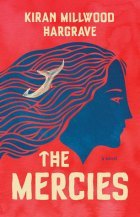 The divide of gender, the dark side of religion, and the resilience of the human spirit are placed beneath the microscope in this evocative historical novel, inspired by real life tragedy. Following a devastating storm that claims the lives of nearly all their men, a remote community of women in 17th century Norway must learn to be self-sufficient. But whispers of witchcraft bring new men to their home; men who are not happy to find a group of women capable of such independence. With subtlety and tact, Hargrave explores the ingrained societal roles that define and separate us, with a particular focus on the trappings of gender and religion. Through the blossoming relationship between the two female leads (one of whom is new to the village), she also touches on the delicate task of bridging class divides, the pain of forbidden love, and the quiet heroism of following your heart when daring to be different is enough to get you killed.
The divide of gender, the dark side of religion, and the resilience of the human spirit are placed beneath the microscope in this evocative historical novel, inspired by real life tragedy. Following a devastating storm that claims the lives of nearly all their men, a remote community of women in 17th century Norway must learn to be self-sufficient. But whispers of witchcraft bring new men to their home; men who are not happy to find a group of women capable of such independence. With subtlety and tact, Hargrave explores the ingrained societal roles that define and separate us, with a particular focus on the trappings of gender and religion. Through the blossoming relationship between the two female leads (one of whom is new to the village), she also touches on the delicate task of bridging class divides, the pain of forbidden love, and the quiet heroism of following your heart when daring to be different is enough to get you killed.
In addition to presenting nuanced, multifaceted characters, she skilfully evokes a very particular time and place. Crystalline prose captures the raw power and awe-inspiring beauty of the landscape, the atmosphere vivid and transporting as a result. Emotional beats hit at all the right moments, culminating in a climax that is all the more thrilling and powerful for its avoidance of certain anticipated tropes. There have been a lot of witch trial inspired novels over the years. Despite that fact, and the responsibility of honouring true historical events, Hargrave has created a story that feels fresh and valuable.
There we have it! What was your top read of 2020?
December 23, 2020
Carol Ann Duffy & Catherine Doyle | Mini Reviews
The Miracle on Ebenezer Street by Catherine Doyle
Published by Puffin, 2020
Rating: 



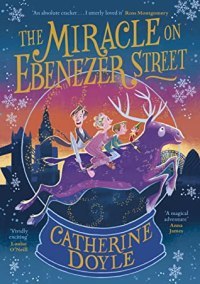 This playful, heartfelt reimagining of Dickens’ A Christmas Carol is set in the present day. We follow George, a ten-year-old boy who lives with his father and grandmother, following the death of his mother three years prior. Overcome by grief, his father has banned Christmas and forbids George from spending time with his mother’s side of the family, finding it too difficult to face his memories of the wife he lost. When George finds a strange snow globe in Marley’s Curiosity Shop, he sparks an adventure full of magic that will take them through Christmas past, present and future.
This playful, heartfelt reimagining of Dickens’ A Christmas Carol is set in the present day. We follow George, a ten-year-old boy who lives with his father and grandmother, following the death of his mother three years prior. Overcome by grief, his father has banned Christmas and forbids George from spending time with his mother’s side of the family, finding it too difficult to face his memories of the wife he lost. When George finds a strange snow globe in Marley’s Curiosity Shop, he sparks an adventure full of magic that will take them through Christmas past, present and future.
Charming and packed full of equal amounts of pathos and humour, Doyle’s love letter to Dickens’ classic is a lovely festive read that celebrates the wonder of the season, while acknowledging it can also be a time of great sadness, as George and his father are forced to confront their grief. Scenes are evoked wonderfully, with vivid descriptions that transport you to Doyle’s enchanting world.
It has to be said, reading a book that centres around the notions of Christmas being cancelled and the sadness of being kept apart from loved ones hits particularly strongly in 2020. On a more personal level, this will also be my first Christmas without my Gran, who passed away earlier this year, and reading about the beautiful relationship between George and his grandmother took on extra resonance as a result.
Bittersweet yet fun and ultimately uplifting, this middle grade novel is a welcome retelling that has enough references to the original to please long-term fans, while still being able to stand on its own merits.
Dorothy Wordsworth’s Christmas Birthday by Carol Ann Duffy
Published by Picador, 2014
Rating: 



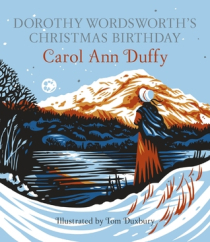 There’s no real emotional or thematic weight to this poem; it simply follows Dorothy, sister of William Wordsworth, as she prepares to enjoy Christmas Day (which also happens to be her birthday) with her brother and their good friend, Samuel Taylor Coleridge. Duffy paints vivid pictures of the wintry setting with some lovey imagery: “Ice, like a cold key, / turning its lock on the lake; / nervous stars trapped there”, and deftly captures the beauty of the quieter moments of domesticity that make the season so cosy and enticing: “The kitchen table, / set for this festive breakfast, / an unseen still life”; “The cat at his feet / licks at her black-and-white fur / rhyming purr with purr.”
There’s no real emotional or thematic weight to this poem; it simply follows Dorothy, sister of William Wordsworth, as she prepares to enjoy Christmas Day (which also happens to be her birthday) with her brother and their good friend, Samuel Taylor Coleridge. Duffy paints vivid pictures of the wintry setting with some lovey imagery: “Ice, like a cold key, / turning its lock on the lake; / nervous stars trapped there”, and deftly captures the beauty of the quieter moments of domesticity that make the season so cosy and enticing: “The kitchen table, / set for this festive breakfast, / an unseen still life”; “The cat at his feet / licks at her black-and-white fur / rhyming purr with purr.”
Every stanza is its own individual haiku, but they all come together to form one narrative poem. To me this felt like a nod to the structure and tradition that many of us cherish on Christmas Day, the consistent rhythm and pace also giving the poem a flowing, gentle quality. Whatever the intention, it’s a nice structural device that, coupled with the simple language, makes this a pleasant, easy read.
Each of Duffy’s annual festive poems is fully illustrated by a different artist, and this one is no exception. Tom Duxbury’s expressive style and limited colour palette are gorgeous, perfectly suited to the comforting vibe of the poem itself.
This will be my last post before Christmas, so however you’re spending it this year, I hope you all have a safe, lovely time. I’ll be back afterwards with my December Wrap Up and my Top Reads of the Year!
December 21, 2020
Let’s Recommend | Christmas Reads
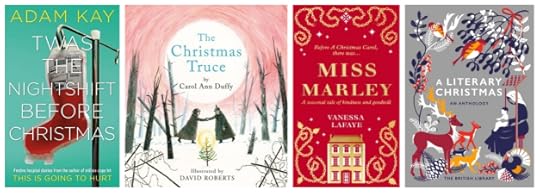
Let’s recommend some Christmas reads!
If anyone is looking for a festive themed read to pick up over the holidays, here are a few recommendations to hopefully point you in the right direction. As always, I encourage you to share your own recommendations in return!
Twas the Nightshift Before Christmas by Adam Kay
This is a series of extracts from the real-life diaries that Kay kept during his time as a junior doctor, taken specifically from the seven festive seasons he spent working on hospital wards. I found it more focussed and affecting than his similar (though not Christmas centred) offering, This is Going to Hurt, and I thought his signature sarcastic humour felt less forced this time around, adding some much needed light to balance out the darkness. Indeed, it’s the kind of book that is just as likely to make you laugh as it is to make you cry. If there was ever a year when we all need to remember the hardships endured by selfless NHS staff, particularly throughout the holidays, it’s this one.
The Christmas Truce by Carol Ann Duffy
For much of her run as the UK’s poet laureate, Duffy released an annual Christmas poem to mark the festive season. Each one was released as a compact little hardback, with accompanying illustrations by a different artist. This particular offering is inspired by the real-life events of Christmas Day, 1914, when opposing sides of the First World War downed their weapons and met on No Man’s Land to play football, exchange gifts, and sing songs. Its messages of coming together to overcome adversity, and finding light amidst the darkest of times resonate particularly strongly this year.
Miss Marley by Vanessa Lafaye
Told from the perspective of Jacob Marley’s sister, Clara, this serves as a prequel to Dickens’ A Christmas Carol, exploring the events that led to her brother’s tragic demise. The best kind of tie-in novel, Miss Marley successfully toes the line between reverence for the original, and the crafting of a story that feels new and worthwhile. Dickens’ existing characters are handled well, while the new ones are inserted seamlessly without contradicting any of the established lore. It manages to build on the core themes of A Christmas Carol, and is a suitably poignant read about class, loyalty, and fate versus freewill.
A Literary Christmas by The British Library
Bringing together short stories, poems, and novel extracts all centred around Christmas, this is an ideal means of trying various authors’ styles and seeing which ones you gel with. It’s mainly classic works but there are a few contemporary writers featured as well. The highlight for me was Christmas at Sea by Robert Louis Stevenson, a poem about a man aboard a fishing vessel whose thoughts turn to home during a storm on Christmas morning. Other highlights included: A Christmas Carol by Christina Rossetti; A Visit from St Nicholas by Clement Clarke Moore; and extracts from Sons and Lovers by D.H. Lawrence, and Little Women by Louisa May Alcott. Charming, well structured, and beautifully presented, it’s great to dip in and out of throughout the holiday.
There we have it! I know Christmas will likely look different for most of us this year, but I hope you all have a safe, lovely time nonetheless. What festive reads would you recommend?



